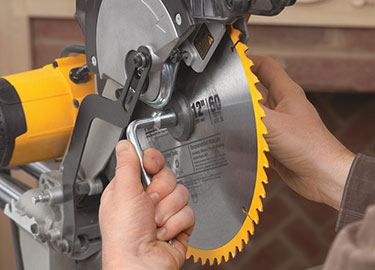
Will a sliding miter saw cause payoff? Truly, one might say. Numerous carpenters know about the terrifying experience of having a sliding miter saw edge tie in bit of wood; in a cut, you feel an unexpected, rough yanking in reverse of the engine and cutting edge unit. Such an occasion isn't as likely as different types of payoff to cause genuine injury, yet it can leave the administrator with a longing to proceed onward to something more secure - like sanding or clearing the floor.
As a rule, the expression "payoff" identifies with fixed carpentry apparatus, which is normally significantly more impressive than a sliding miter saw. Genuine payoff happens when the sharp edge or shaper of a carpentry machine ties on a bit of stock and rushes it back toward the administrator. In contrast with miter saw payoff, this is a considerably more difficult circumstance. The abrupt movement can bring your hand into contact with the bit or sharp edge. Or then again, in a most dire outcome imaginable, you could be hit or pierced with the flung-back bit of stock.
With a sliding miter saw, "payoff" happens when the sharp edge gets hung up on the material during the cut. In the event that the material is tight facing the saw's fence - as it ought to be - the outcome will be an abrupt power pushing the saw engine and edge get together outwards toward the client. While this is unquestionably alarming, it as a rule doesn't prompt genuine results - gave the administrator is following essential wellbeing techniques.
Regardless of whether you do observe essential miter saw wellbeing rules - keeping your free hand well out of the way of the sharp edge; wearing security hardware; ensuring any edge settings are safely secured; keeping the material up close against the fence and bed of the instrument, and so on (allude to your saw's proprietor's manual for a more complete rundown) - you may experience this intermittent astonishment. The most widely recognized is the one portrayed above, where the cutting edge stalls out in the material and, on account of a sliding saw, is moved toward the client.
What causes this? Miter saw payoff happens when the kerf (the space made by the edge) surrounds the cutting edge and "snatches" it. It happens every now and again when crosscutting long, wide sheets close to the center. At the point when wood isn't completely straight and level, it can't be held in firm contact with the fence and bed of the saw at each point. As the cut continues and the wood draws into nearer contact with the fence and additionally bed, the kerf changes shape and can encroach on the way of the sharp edge. When cutting long, wide stock on a sliding miter saw, a few carpenters like to begin by making a fractional cleave cut close to the fence side of the sharp edge. Doing this mellow the impacts of any coupling that happens.
Different variables add to sharp edge authoritative, including a couple of that are completely preventable. Wet wood or wood with a high pitch content is more "clingy" and can be more snatch inclined. A dull or improper edge will likewise have even more a propensity to tie. On a sliding miter saw, a dull edge with a forceful snare point and too barely any teeth is a formula for spiked cuts, short pieces of cutoff ricocheting here and far off, and a for the most part undesirable sawing involvement with the exceptionally least. A quality sharp edge intended for use on a miter saw won't just assistance cut down on authoritative, however will likewise improve things significantly in nature of cut the saw conveys.
You ought to likewise check to ensure the saw is working appropriately. The sharp edge needs follow a completely straight way all through the slice to abstain from scouring toward the kerf. Ensure that slant and miter settings are holding quick, that the cutting edge is on close, and that there's no obvious slop in any of the working parts.
It's a smart thought to ensure that the different sides of the fence are on a similar plane. On the off chance that they are not, and the fence isn't customizable, the issue can be adjusted by including a shop-made sub-fence to ether side and shimming until the two are actually coplanar. On the off chance that everything is working accurately and you are utilizing a sharp, fitting cutting edge, by far most of your cuts ought to be close to glass smooth and inconvenience free.
Another horrendous miter saw occasion happens when the sharp edge gets the edge of a bit of cutoff and flames it over the shop. Happening frequently with little bits of stock, this kind of "payoff" is once in a while places the administrator in incredible physical peril (insofar as suitable security gear is being used). Be that as it may, it is surprising, and can be irritating when the sawn-off shot - which can be incredibly hard to track down - is the part you need.
No comments:
Post a Comment